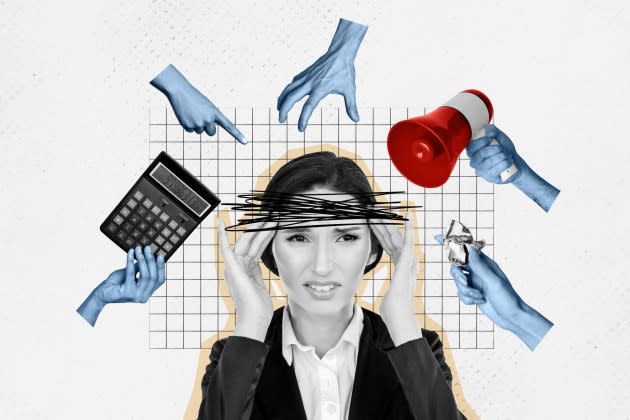Consumers Feel Stuck — and the Implications for Retail Are Huge


Call them the stuck in the middle consumer.
They are everywhere. They feel all right about right now, but bad about their future. Buoyed by higher wages and pressured by high prices. Divided, frustrated and worn out by politics. Worried over the state of the world — from wars to climate change. Keen on sustainability, but guilty when they buy that extra top.
More from WWD
Younger Americans Are Set to Have a Summer of Fun, No Matter the Financial Costs
Weight Loss Drugs Are Poised to Cost New York City Retail, According to Study
It’s a mess that is expected to have outsized implications for retailers, where brands and stores are all looking for some way to move forward, but are stuck too, waiting for trade winds to blow one way or the other.
And don’t expect that to change soon.
With the presidential debate Thursday set to kick off a new phase of an already ugly rematch between President Joe Biden and his predecessor Donald Trump, consumers seem caught somewhere between screaming their heads off and near-complete apathy.
“It’s not like there’s actually that much new news — with politics, with global conflict, with prices,” said Katie Thomas, who leads the Kearney Consumer Institute think tank and keeps close tabs on shoppers’ habits. “It’s not the news. It’s the fact that it’s not new news. Nothing’s changed.”
Thomas said people are feeling a “sense of resignation.”
“It’s death by a thousand cuts and all sorts of little things coming together,” she said. “People are going to keep on keeping on, but the election, it’s going to be bumpy. Then once that happens, it’ll start to settle down a little.”
This month, The Conference Board’s Consumer Confidence Index slumped down to 100.4 from 101.3 in May. Behind that number, forces are pulling the shopping psyche in opposite ways.
The Present Situation Index, which makes up half the broader index, rose to 141.5 from 140.8. But the Expectations Index, which looks six months out, fell to 73 from 74.9. (The index has spent five months below 80, the level that typically signals a recession ahead.)
What’s a brand to do? How can retailers connect?
“The real money is in deepening the feedback,” said Thomas, highlighting the need to really connect with consumers. “For too long, we relied on just quantitative data and we have so much data — we try to use data to tell us everything.”
Fashion needs to have “really good conversations with their consumers,” she said. “Luxury does it well because they learn a lot about their high net worth people and that’s a good loop then that can happen there.”
But sometimes when talking to consumers, it’s important to listen not just to the shouting, but to the quieter voices.
Marcie Merriman, cultural insights and customer strategy leader at Ernst & Young, pays close attention to these “weak signals” as she parses the consumer, she said.
“A lot of times, the weak signals just need something to hit the tipping point,” Merriman said. “That’s where, with elections, if the stock market were to drop, you hit the tipping point and that’s where the weak signals go to Main Street.”
Merriman has been focusing on younger consumers — the 18- to 34-year-olds — and said there are hints of trends that could grow to be important.
“With younger consumers — I saw this even before COVID[-19] — where they were just constantly waiting from a financial standpoint for the bottom to fall out. It is this constant dread of, something horrible is going to come and what you should be doing and what others are doing.”
Merriman said 73 percent of people in the U.S. worry they’re not handling their money properly.
There’s also an environmental dread that’s not exactly jibing with consumer behavior.
“They worry about climate change, but they’re still buying the shirt,” Merriman said. “What we hear from them is, ‘Yes, I’m buying the shirt. I know I shouldn’t have. I know I’m only going to wear it once. I know it’s bad for the environment, but yeah, I needed it.’”
That purchase might help sales today, but creates a base that will be harder to build on for the future.
“If the consumer feels guilty about buying your product, if they have to justify it, it’s not a long-term strategy,” she said. “You may still be able to eke out a little bit more of the cash cow, but there’s so many weak signals that demonstrate the longer term strategy is more about the quality things that are going to last.”
That striving for quality extends to both the things people buy and their day-to-day experiences IRL.
Merriman said young people are “wanting to break away from the phone and the technology. It doesn’t mean they’re successfully doing it. There’s a desire. And when I think about what this means for retailers, and that’s why I think the physical store has an opportunity.”
Consumers are mixed up and stuck, almost dumbfounded by the election and an economy that is at turns promising and frightening.
But when they get unstuck, or something in the gridlock breaks, they could move quickly — and remake the retail world again.
The Bottom Line is a business analysis column written by Evan Clark, deputy managing editor, who has covered the fashion industry since 2000. It appears every other Thursday.
Best of WWD

 Yahoo Finance
Yahoo Finance 